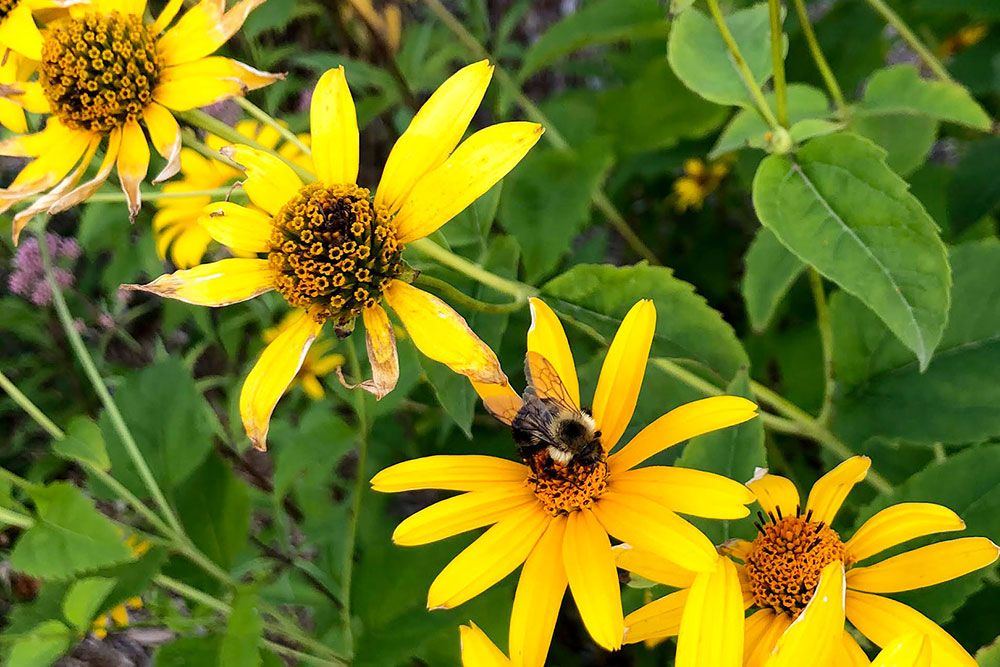Rural and urban stewardship is piece of the puzzle

Stewardship by rural and urban landowners is an important piece of the puzzle for Lake Huron
By Jessica Van Zwol, Healthy Watershed Specialist, St. Clair Region Conservation Authority
You are an important piece of the puzzle in the work to protect Lake Huron. This is true whether you live or work in the countryside or in a village, town or city.
You can help to ensure this Great Lake remains great by choosing landscaping options that manage stormwater runoff, such as:.
- Harvest your rainwater: directing downspouts into rain barrels can provide free rainwater that can be used in your gardens, potted plants, and hanging baskets.
- Naturalize your lawn and gardens with native plants. Native-to-Ontario plants:
- Can withstand our droughty Ontario summers, thereby reducing the need to water often. Some species of native grasses and wildflowers have much deeper root systems (up to 3.5 metres long) compared to the 10-15 centimetre (cm) root systems of most turf grasses. These deep roots can tap into groundwater resources. A typical lawn requires up to four times as much water as other plants (SOURCE: Toronto Region Conservation Authority, Greening Your Grounds).
- Require minimal, if any, fertilizers because they are adapted to local soil conditions.
- Provide food and shelter for pollinating insects, butterflies and songbirds.
- Create a rain garden: Rain gardens look like regular gardens, but they have loose, deep soil that allows them to absorb excess water after rain events, filter out pollutants, and recharge the groundwater supply.
- Plant more shrubs and trees: This action can not only provide habitat and shelter for native wildlife, but it can also reduce overland runoff on your property and reduce the loss of nutrients and soil.
- Pave permeably: Use patio pavers instead of concrete for driveways, walkways, and patios, as this method allows high infiltration of water.
- Your local conservation authority staff are here to help. They can connect landowners with resources and financial incentives. Such projects include wetland creation and restoration, planting riparian buffers, and mitigating erosion and runoff. Landowners can meet with staff on their property to discuss project design and implementation. Staff can offer advice, suggest contractors, and answer questions about the process of implementing conservation projects on their property. Grant availability for such projects depends on what funding sources are currently available.
The goal of Healthy Lake Huron is to improve rural water quality and the overall health of Lake Huron. If you are a rural landowner along the southeast shores of Lake Huron (Sarnia to Tobermory) who is interested in learning more about improving water quality, check out the map of Lake Huron's southeast shore at healthylakehuron.ca or reach out to stewardship staff in your area.
- St. Clair Region Conservation Authority – Jessica Van Zwol, Healthy Watershed Specialist, by email at jvanzwol@scrca.on.ca or by phone at 519-245-3710, extension 241.
- Ausable Bayfield Conservation Authority – Brooklyn Rau, Stewardship Technician, by email at brau@abca.ca or by phone at 519-235-2610, or toll-free 1-888-286-2610, extension 261.
- Maitland Valley Conservation Authority – Ben Van Dieten, Agricultural Stewardship Supervisor, by email at bvandieten@mvca.on.ca or by phone at 519-335-3557, extension 245.
- Saugeen Valley Conservation Authority – Donna Lacey, Manager of Forestry and Lands, phone 519-369-7516.
- Grey-Sauble Conservation Authority – Keith Reid, Stewardship Technician, by email at k.reid@greysauble.on.ca or by phone at 1-548-877-0583.
- Stay tuned. A Greening Your Grounds workshop will be held Summer 2024 in the Lambton Shores area. If you wish to be informed as details are finalized, please reach out to Jessica Van Zwol, Healthy Watershed Specialist, by email at jvanzwol@scrca.on.ca or phone 519-245-3710, extension 241, to be added to the list.
#HealthyLakeHuron #LandtoLake #PieceofthePuzzle
